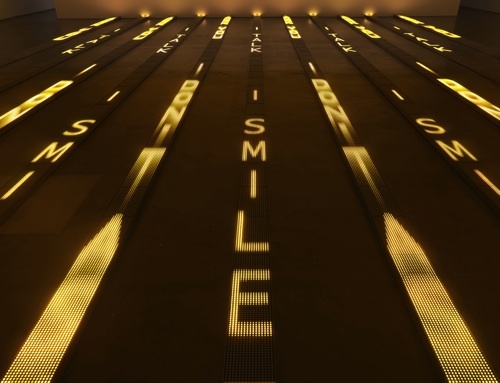
Hey! Pay Attention
Jenny Holzer's must-see new show at Montreal's DHC/ART gallery
“I do tend to make work that focuses on cruelty, in hopes that people will recoil,” Jenny Holzer has said. The American conceptual artist's most recent exhibition, currently on display at Montreal's DHC/ART, is political, affecting and effective, making use of declassified US government documents about the Iraq War and the treatment of detainees at Guantanamo Bay. The art’s spareness—a simple black and white silkscreen of an autopsy report, for instance, or a soldier’s testimony scrolling across LED screens—renders these moments in a way that is piercingly real.
Holzer is best-known for her text-based works, such as her 1970s Truisms series, which stretched phrases like “Abuse of power comes as no surprise” across posters and billboards. The most unsettling work in her latest exhibition, from her series Redaction Paintings, has more to do with what isn't said. Holzer obtained heavily censored documents through the Freedom of Information Act and silkscreened them, as is, onto large white linen canvases. Text is intermingled with black, geometric shapes made by redacted, or censored, words and phrases. The redactions only highlight the text left intact; in a chain of emails pertaining to “alternative interrogation techniques,” senior policy makers misspell words and stumble over basic grammar, realities of everyday email exchanges we might assume would be absent from high-level conversations about war strategy. But the works are also eerily vague; in some pieces, massive chunks of documents are redacted, leaving only a few words. On one canvas, only two remain: “water board.”
The unmoving finality of these works makes an interesting contrast with the LED pieces also on display. “Thorax” (2008) is a structure composed of numerous LED tickers programmed with conflicting reports about the death of an Iraqi civilian at the hands of the American military. The text speeds across the screens rapidly—censored passages marked by flashing Xs—making it difficult to draw out and process the information. The viewer has to work through the muddle to glean the true meaning of the text, just as we have to sift through often contradictory information from a barrage of news sources, government officials, and commentators.
“I want to be able to continue to … pull from good and ghastly text,” Holzer has said, “to offer these to people—present them in ways that are lovely and exacting.” By bringing the documents, and the stories they tell, out of filing cabinets and onto the walls of an art gallery, Holzer further democratizes and publicizes them.
As the viewer watches text scroll by on the LED screens, word after word, it’s tempting to fall into a trance-like state, lulled by the steady stream of sometimes-incomprehensible words. But then, all of a sudden, the screens flash on and off, or reverse direction, perhaps to recapture the viewer’s full attention. As though it’s Holzer shouting, “Hey! Pay attention. This is important.”
The exhibition is on display at DHC/ART (451 St. Jean St., Montreal) through November 14
Related on maisonneuve.org:
—The Art of Personal Space
—The Art of Knit Graffiti
—Exploring Outer Space through Architecture
Follow Maisonneuve on Twitter — Join Maisonneuve on Facebook





